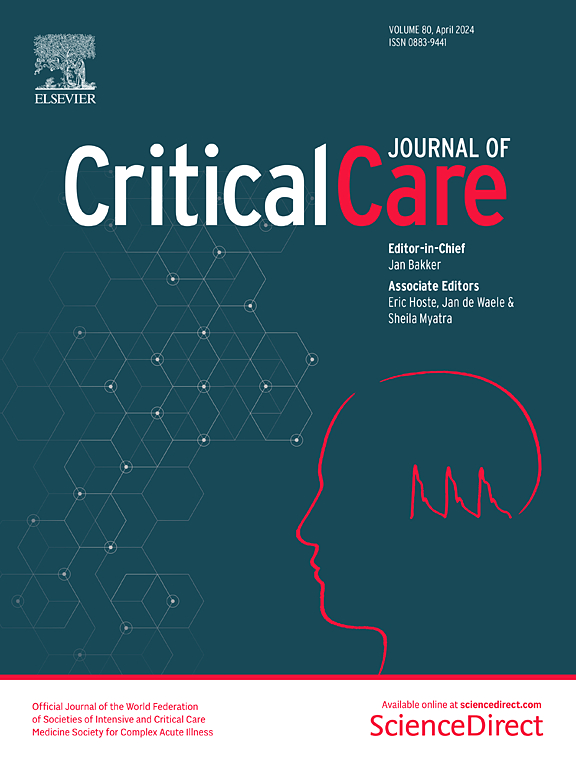不同尖端和长度的导尿管用于重症监护病房持续肾替代治疗患者的随机对照试验
IF 8.8
1区 医学
Q1 CRITICAL CARE MEDICINE
引用次数: 0
摘要
导管的尖端设计和长度影响导管的功能。在持续肾替代治疗(CRRT)中,常用两种不同尖端的导管:侧孔导管和阶梯尖端导管。然而,目前还没有足够的证据来比较它们在CRRT中的有效性和安全性。此外,是否插入更长的导管可以增强导管功能的研究仍然很少和有争议。在这项开放标签、三组随机试验中,接受CRRT治疗的危重患者被随机分为三组。A组采用20 cm侧孔导管(GDHK‐1120),B组采用20 cm阶梯尖导管(GDHK‐1320),C组采用25 cm阶梯尖导管(GDHK‐1325)。主要结果为导管功能障碍发生率和导管存活时间。共纳入351例患者,其中A组116例,B组117例,c组118例。A组导管功能障碍发生率(35.7%,51/143)显著高于B组(17.7%,22/124)(P = 0.001)。B组与C组比较差异无统计学意义(15.6%,23/147)(P = 0.744)。A组(5.5 d, IQR 2.5 ~ 9.3)与B组(5.0 d, IQR 3.0 ~ 10.0)的导管生存时间比较,差异有统计学意义(P = 0.626)。相比之下,C组(6.4天,IQR为3.9 ~ 12.0)的导管生存时间明显长于B组(P = 0.019)。Cox回归分析发现BMI (HR 1.052, 95% CI 1.003-1.103, P = 0.036)是导管功能障碍的独立危险因素。不同BMI分位数的结果并不一致,只有BMI较低(BMI < 24.2)的患者才有类似的结果(卡方13.65,P = 0.001)。C组患者滤芯寿命更长(36.5 h, IQR为16.9 ~ 68.1,P = 0.001),导管相关血栓发生率更低(10.40 / 1000导管天,95% CI为5.93,17.83,P = 0.019)。其他次要结局组间无显著差异。对于CRRT,特别是对于BMI指数较低的不育患者,步尖导管可能更可取。较长的股静脉置管在CRRT中显示出更大的益处,特别是在肥胖患者中。进一步的高质量、多中心随机对照试验对于加强CRRT过程中导管选择的循证指导至关重要。试验注册:ChiCTR2300075107。2023年8月25日注册本文章由计算机程序翻译,如有差异,请以英文原文为准。
A randomized controlled trial of catheters with different tips and lengths for patients requiring continuous renal replacement therapy in intensive care unit
The tip design and length of catheter impact catheter function. Two types of catheters with different tips, side-hole catheters and step-tip catheters, are commonly used during continuous renal replacement therapy (CRRT). However, there is insufficient evidence comparing their efficacy and safety in CRRT. In addition, whether the insertion of a longer catheter could enhance catheter function remains poorly studied and controversial. In this open-label, three-arm, randomized trial, critically ill patients receiving CRRT were randomized to three groups. Group A received 20 cm side-hole catheters (GDHK‐1120), group B received 20 cm step-tip catheters (GDHK‐1320) and group C received 25 cm step-tip catheters (GDHK‐1325). The primary outcomes were the incidence of catheter dysfunction and catheter survival time. A total of 351 patients were enrolled, with 116 in group A, 117 in group B, and 118 in group C. The incidence of catheter dysfunction in group A (35.7%, 51/143) was significantly higher than that in group B (17.7%, 22/124) (P = 0.001). However, there was no difference between group B and group C (15.6%, 23/147) (P = 0.744). The catheter survival time was comparable between group A (5.5 days, IQR 2.5–9.3) and group B (5.0 days, IQR 3.0–10.0) (P = 0.626). In contrast, group C (6.4 days, IQR 3.9–12.0) demonstrated a significantly longer catheter survival time compared to group B (P = 0.019). Cox regression analysis identified BMI (HR 1.052, 95% CI 1.003–1.103, P = 0.036) as an independent risk factor for catheter dysfunction. Results were not consistent across BMI tertiles, with similar results observed only in patients with a lower BMI (BMI < 24.2) (chi-square 13.65, P = 0.001). There was also a trend that patients in group C have a longer filter lifespan (36.5 h, IQR 16.9–68.1, P = 0.001) and a lower incidence of catheter-related thrombosis (10.40 per 1000 catheter-days, 95% CI 5.93, 17.83, P = 0.019). Other secondary outcomes were not significantly different among groups. Step-tip catheters may be preferable for CRRT, particularly for patients in the lower BMI tercile. Longer femoral vein catheterization demonstrated enhanced benefits in CRRT, especially among obese patients. Further high-quality, multicenter RCTs are essential to strengthen the evidence guiding catheter selection during CRRT. Trial registration: ChiCTR2300075107. Registered 25 August 2023.
求助全文
通过发布文献求助,成功后即可免费获取论文全文。
去求助
来源期刊

Critical Care
医学-危重病医学
CiteScore
20.60
自引率
3.30%
发文量
348
审稿时长
1.5 months
期刊介绍:
Critical Care is an esteemed international medical journal that undergoes a rigorous peer-review process to maintain its high quality standards. Its primary objective is to enhance the healthcare services offered to critically ill patients. To achieve this, the journal focuses on gathering, exchanging, disseminating, and endorsing evidence-based information that is highly relevant to intensivists. By doing so, Critical Care seeks to provide a thorough and inclusive examination of the intensive care field.
 求助内容:
求助内容: 应助结果提醒方式:
应助结果提醒方式:


